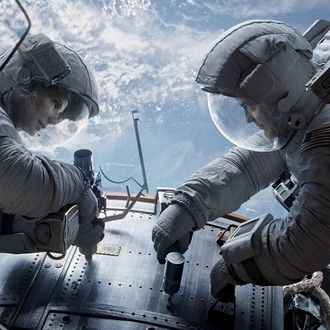
Last month, Warner Bros. released three amazing, tension-filled clips (here and here) from Gravity, director Alfonso Cuarón’s first movie since 2006’s Children of Men. Starring George Clooney and Sandra Bullock as a pair of astronauts, it opened the Venice Film Festival today to rave reviews in which everyone basically says that seeing the movie is as close to being in space as any of us is going to get. Gravity doesn’t open in the U.S. until October 4, so it’s up to you if you want to read reviews this early. If so, proceed:
“At once the most realistic and beautifully choreographed film ever set in space, Gravity is a thrillingly realized survival story spiked with interludes of breath-catching tension and startling surprise…Seeing is what it’s mostly about here, seeing space as if the film was actually shot there. It’s a wonderful cinematic jolt to watch this film for the first time, as it looks as if it had been filmed, as it were, on location.” —Todd McCarthy, The Hollywood Reporter
“Gravity is very much an action adventure film, one very occasionally more meditative than most, but it’s unashamed in its desire to thrill you … The film comes as close as most of us are likely to get to actually being in space (undoubtedly aided by the 3D: this is one film that’s really worth paying the extra bucks for to see in the format, whether the lens is capturing a tiny spinning speck in the distance or debris flying in your face). But it shouldn’t be dismissed as a mere rollercoaster ride — even if your instinct, as at a theme park, is to finish the experience and line up again for another go … ‘Gravity’ is about as visceral an experience as you can have in a cinema, it’s a technical marvel, and it’s a blockbuster with heart and soul in spades.” —Oliver Lyttelton, the Playlist
“[It’s] one of the most sophisticated and enveloping visions of space travel yet realized onscreen…While Gravity is hardly the first film to send characters into orbit, few have so powerfully and subjectively evoked the sensation of floating right there with them. As it glides nimbly around the action, the camera induces a deeply pleasurable feeling of weightlessness (the film might just as well have been titled ‘Dancing With the Stars’) that can suddenly turn from exhilarating to terrifying, leaving us gasping for oxygen alongside the characters.” —Justin Chang, Variety
“It comes blowing in from the ether like some weightless black nightmare, hanging planet Earth at crazy angles behind the action. Like Tarkovsky’s Solaris (later remade by Clooney and director Steven Soderbergh), the film thrums with an ongoing existential dread.” —Xan Brooks, Guardian
“Life in space — impossible and urgently temporary as it may be — is pretty unbeatable, relieving its inhabitants of all accepted rules and limitations of physicality, movement and sound travel; it’s 45 years since Kubrick’s 2001: A Space Odyssey effectively patented the description ‘the ultimate trip,’ but that doesn’t mean Cuarón and his team can’t further serve and substantiate it. Certainly, the unfeasibly mobile camera of Cuarón’s loyal, invaluable cinematographer Emmanuel Lubezki seems drugged — or perhaps purely entranced — by its possibilities, gliding and weaving across seemingly impracticable distances with a deliberate fluidity that no previous screen depiction of weightlessness (whether in outer space or the subconscious hotel suites of Christopher Nolan’s mind) has come close to approximating … When I stood up as the final credit rolled, I don’t mind admitting that I immediately had to sit down again, a Bambi-like wobble coursing through my limbs, as if I’d just re-encountered gravity myself. F for sheer transference of experience upon the audience, I can think of no film quite like it.” —Guy Lodge, HitFix
“This amazing 13-min. sequence at the very beginning of Gravityis shown in a single shot. To say this is a marvel of camerabatics, of visual choreography, animation and physical acting (Bullock and Clooney worked on wires in front of a green screen) is to undersell Cuarón’s gift as a storyteller who takes the audience on a nail-gnawing space flight.” —Richard Corliss, Time

